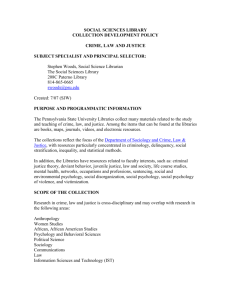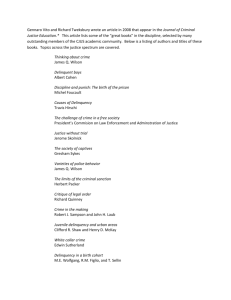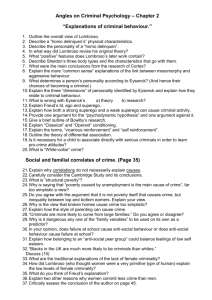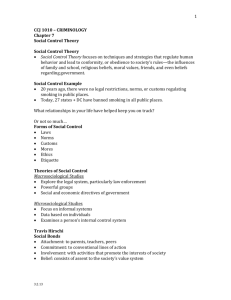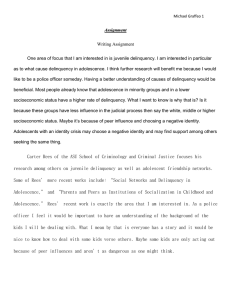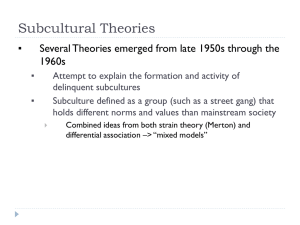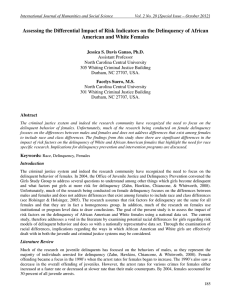Ch. 2_CRJU 2070e
advertisement
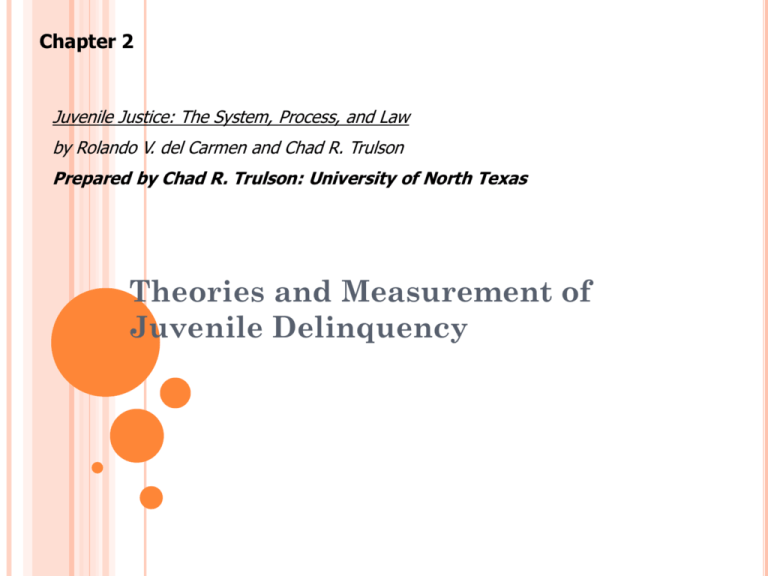
Chapter 2 Juvenile Justice: The System, Process, and Law by Rolando V. del Carmen and Chad R. Trulson Prepared by Chad R. Trulson: University of North Texas Theories and Measurement of Juvenile Delinquency THE EMERGENCE OF THE CLASSICAL SCHOOL The Devil and Delinquency Prior to the 1700’s, the dominant view was that “criminal behavior” occurred because of “temptation” or being “possessed” by the devil “Trial by ordeal” was designed to test whether the individual was under the influence of the devil or would be protected by God THE EMERGENCE OF THE CLASSICAL SCHOOL Beccaria and Free Will Classical school – human beings rationally weighed the costs and benefits of committing a crime Theorized a system of punishments where the costs of committing a crime outweighed the benefits of that crime To deter crime, punishment should be swift, certain and severe but must also be proportionate to the crime committed Certainty was said to be most important BIOLOGY, DETERMINISM AND THE POSITIVE SCHOOL Determinism – the causes of delinquency are predetermined to the individual or environmental factors. Crime is not the result of choice and free will Positivism – a perspective of thought in which causes of behavior can be measured and observed Positive school – application of scientific principles to the study of crime BIOLOGY, DETERMINISM AND THE POSITIVE SCHOOL Lombroso and the Atavist Cesare Lombroso proposed that criminals were biologically inferior or different than non-criminals Atavists – born criminals that could be recognized through certain physical characteristics or “stigmata” PSYCHOLOGICAL EXPLANATIONS OF DELINQUENCY Sigmund Freud believed criminal behavior was caused by improper formation of the three components of the personality: Id – desire for things, primitive instinct Ego – part of the personality that organizes and decides between choices and alternatives Superego – a person’s conscience, which suppresses impulses Proper or improper formation is determined early in a person’s life Emphasized the importance of parents SOCIOLOGICAL EXPLANATIONS OF DELINQUENCY Sutherland’s Differential Association Theory Criminal behavior is learned through communication with primary influences A person becomes delinquent because of an exposure to more definitions favorable to violation of law than unfavorable Definitions are rationalizations and attitudes for or against criminal behavior May vary in frequency, duration, priority and intensity Much more than a theory of “bad companions” SOCIOLOGICAL EXPLANATIONS OF DELINQUENCY Akers's Social Learning Theory Delinquency occurs when individuals: Associate with others who commit criminal behavior Are more exposed to definitions favorable to committing crime Define criminal behavior as desirable or justified in a situation Have received in the past or expect in the future greater rewards than punishment for the behavior SOCIOLOGICAL EXPLANATIONS OF DELINQUENCY Social Bonding and Control Theory Social bonding tries to answer why everyone does not commit crime. Travis Hirschi states it is because people are bonded to society: Attachment – to parents, schools and peers Commitment – degree to which an individual is invested, if they have a “stake in conformity” Involvement – in conventional activities Belief – extent to which individuals subscribe to general laws and rules Delinquency occurs when the bonds to society are weakened or broken SOCIOLOGICAL EXPLANATIONS OF DELINQUENCY Labeling Theory Societal reaction – negative activity could lead to labeling and a self-fulfilling prophecy People can have identity transformations – based on how others react to them because of a label Primary deviance vs. Secondary deviance
